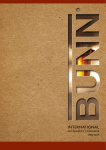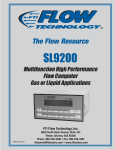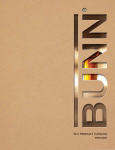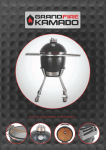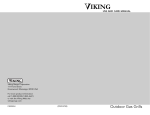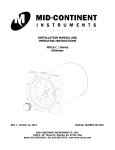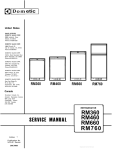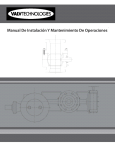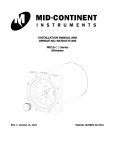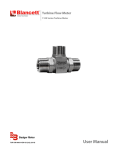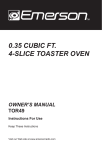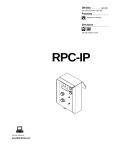Download Flow Technology FTO Turbine Flowmeter Installation, Operation and
Transcript
8930 South Beck Avenue, Suite #107• Tempe, Arizona 85284 U.S.A. Telephone (480) 240-3400 • Fax (480) 240-3401 ● www.ftimeters.com FTO TURBINE FLOWMETER Installation, Operation and Maintenance Manual SERIAL NUMBER_________________________________ The specifications contained in this manual are subject to change without notice and any user of these specifications should verify from the manufacturer that the specifications are currently in effect. Otherwise, the manufacturer assumes no responsibility for the use of specifications that have been changed and are no longer in effect. FTO TURBINE FLOWMETER Installation, Operation and Maintenance Manual TM-86674 REV. K PUBLISHED BY FLOW TECHNOLOGY, INC. – February 2008 TM-86674 i Thank you for selecting a FLOW TECHNOLOGY, INC. product for your flow measurement application. Virtually every major commercial, government, and scientific organization is making use of our products, expertise and extensive technical support. This is a culmination of years of refinement in our flowmeter and calibrator designs that has resulted in the technological leadership in the flow measurements field that we enjoy. We are proud of our quality products, our courteous service and welcome you, as a valued customer, to our growing family. TM-86674 i WARRANTY Limited Warranty. Seller warrants that goods delivered hereunder will at delivery be free from defects in materials and workmanship and will conform to seller's operating specifications. Seller makes no other warranties, express or implied, and specifically makes NO WARRANTY OF MERCHANTABILITY OR FITNESS FOR A PARTICULAR PURPOSE. Limitation of Liability. Seller's obligation under the warranty shall be limited to replacing or repairing at Seller's option, the defective goods within twelve (12) months from the date of shipment, or eighteen (18) months from the date of shipment for destination outside of the United States, provided that Buyer gives Seller proper notice of any defect or failure and satisfactory proof thereof. Defective goods must be returned to Seller's plant or to a designated Seller's service center for inspection. Buyer will prepay all freight charges to return any products to Seller's plant, or other facility designated by Seller. Seller will deliver replacements for defective goods to Buyer freight prepaid. The warranty on said replacements shall be limited to the unexpired portion of the original warranty. Goods returned to Seller for which Seller provides replacement under the above warranty shall become the property of the Seller. The limited warranty does not apply to failures caused by mishandling or misapplication. Seller's warranty obligations shall not apply to any goods that (a) are normally consumed in operation or (b) have a normal life inherently shorter than the warranty period stated herein. TM-86674 In the event that goods are altered or repaired by the Buyer without prior written approval by the Seller, all warranties are void. Equipment and accessories not manufactured by Seller are warranted only to the extent of and by the original manufacturer's warranty. Repair or replacement goods furnished pursuant to the above warranty shall remain under warranty only for the unexpired portion of the original warranty period. Should Seller fail to manufacture or deliver goods other than standard products appearing in Seller's catalog, Seller's exclusive liability and Buyer's exclusive remedy shall be release of the Buyer from the obligation to pay purchase price therefor. THE FORGOING WARRANTIES ARE IN LIEU OF ALL OTHER WARRANTIES WHETHER ORAL, WRITTEN, EXPRESSED, IMPLIED OR STATUTORY. IMPLIED WARRANTIES OF FITNESS AND MERCHANTABILITY SHALL NOT APPLY SELLER'S WARRANTY OBLIGATIONS AND BUYER'S REMEDIES THEREUNDER (EXCEPT AS TO TITLE) ARE SOLELY AND EXCLUSIVELY AS STATED HEREIN. IN NO CASE WILL SELLER BE LIABLE FOR SPECIAL, INCIDENTAL OR CONSEQUENTIAL DAMAGE. The total liability of Seller (including its subcontractors) on any claim whether in contract, tort (including negligence whether sole or concurrent) or otherwise, arising out of or connected with, or resulting from the manufacture, sales, delivery, resale, repair, replacement or use of any goods or the furnishing of any service hereunder shall not exceed the price allocable to the product or service or part thereof which gives rise to the claim. ii TM-86674 REVISIONS DATE REVISION ECO NUMBER APPROVAL A B 03/11/97 C 11265, 12724, 12752 E. Knowles 06/13/98 D 13319 E. Knowles 03/01/99 E 14098 T. ROY 03/10/2000 F 14563 T. ROY 8/30/2002 G 16055 J. BLASIUS 1/5/05 H 17730 J. BLASIUS 1/12/07 J 19019 R.REED 3/4/08 K 19693 R. REED TM-86674 iii TABLE OF CONTENTS SECTION 1.0 2.0 3.0 4.0 4.1 4.2 4.3 4.4 5.0 5.1 5.2 5.3 5.4 6.0 6.1 6.2 6.3 6.4 6.4.1 6.4.2 6.5 7.0 7.1 7.2 7.2.1 7.2.2 7.3 8.0 8.1 8.2 8.3 8.4 8.5 8.6 TM-86674 TITLE SCOPE PURPOSE DESCRIPTION INSPECTION AND INSTALLATION INSPECTION UPON RECEIPT INSTALLATION ELECTRICAL CONNECTIONS PICKOFFS INSTALLATION OPERATION OVER RANGE UNDER RANGE FLOWMETER LIQUID CHARACTERISTICS FLOWMETER GAS CHARACTERISTICS SPECIFICATIONS AND OPTIONS END CONNECTIONS CALIBRATION SERVICE CONSTRUCTION MATERIALS MATERIALS OF CONSTRUCTION BEARINGS PICKOFFS MAINTENANCE ROUTING MAINTENANCE REPAIRS STANDARD CAPSULE REPLACEMENT HIGH TEMPERATURE & EXOTIC MATERIAL CAPSULE REPLACEMENT PARTS LIST TROUBLESHOOTING GUIDE METER READS HIGH METER READS LOW ZERO OUTPUT INTERMITTENT OPERATION NON-REPEATABLE METER CONSTANT METER OUTPUT iv PAGE 1 1 1 3 3 3 7 7 10 10 10 10 12 13 19 19 20 20 21 22 23 25 25 26 26 27 30 32 32 35 39 43 44 45 TABLE OF CONTENTS (FIGURES AND TABLES) NUMBER TITLE FIGURE 1 FIGURE 2 FIGURE 3 FIGURE 4 FIGURE 5 FIGURE 6 FIGURE 7 FIGURE 8 FIGURE 9 TABLE 1 TABLE 2 TABLE 3 TABLE 4 TABLE 5 TABLE 6 TABLE 7 TANGENTIAL FLOW DIMENSIONS, FLANGED FTO DIMENSIONS, MS OR NPT PICKOFF CONNECTIONS TO ELECTRONICS MAGNETIC PICKOFF CONNECTIONS TYPICAL DEVIATION CURVES CAPSULE ALIGNMENT CAPSULE INSTALLATION INTO FTO HOUSING ILLUSTRATED PARTS BREAKDOWN FTO MODEL NUMBERING SYSTEM PERFORMANCE SPECIFICATION FLOW RANGES BEARING TYPE BEARING APPLICATION GUIDE PICKOFF CHARACTERISTICS ILLUSTRATED PARTS LIST TM-86674 PAGE v 2 5 6 9 9 16 28 29 31 14 15 17 20 22 24 30 1.0 SCOPE This manual provides information and guidance for the installation, operation and maintenance of the FTO Flowmeter, manufactured by Flow Technology, Inc. Phoenix, Arizona. 2.0 PURPOSE The contents of this manual are for general information and to describe the operational characteristics of the FTO Flowmeter. This manual does not include information pertaining to special equipment applications, nor does it include instructions for factory repairs. 3.0 DESCRIPTION The FTO flowmeter is an in-line volumetric flow metering device utilizing a blade rotor to generate flow information. The FTO has the ability to measure very low liquid or gas flows under high temperature and pressure conditions with accuracy and reliability. A precision orifice within the meter, directs all of the measured fluid tangentially (See Figure 1) past the underside of a paddle blade rotor. The rotor rotates in a plane in line with the fluid's motion in the same manner as an undershot water wheel. The rotor is freely suspended and of low mass, so it rotates with a speed relative to the velocity of the flowing medium within the meter. The pickoff is located externally and adjacent to the rotor. The pickoff, in conjunction with an amplifier, senses the rotation of the rotor and provides an output pulse whose frequency is correlated with the fluid flow rate. The sum of the output pulses corresponds to the total volume of the fluid being measured. These pulses can be fed into digital totalizers, frequency to DC converters, or any of the many frequency indicating, recording, and control devices available within the field. TM-86674 1 Figure 1. Tangential Flow TM-86674 2 4.0 INSPECTION AND INSTALLATION 4.1 INSPECTION UPON RECEIPT The FTO flowmeter should be unpacked carefully and inspected to verify that no damage occurred during shipment. Make certain that the flowmeter internal parts are clean and free from packing materials or debris. CAUTION A flowmeter is a precision instrument and may be damaged if a high pressure air hose used for cleaning the meter or for checking the rotation of the rotor. 4.2 INSTALLATION 4.2.1 The FTO flowmeter is normally mounted with the rotor shaft in a horizontal position and the pickoff vertical. Two exceptions to this recommendation are: 1. If it is specifically noted otherwise on the flowmeter calibration data sheet. The flowmeter must be calibrated in the attitude that it is to be mounted to provide accurate measurement throughout the calibrated flow range. 2. 2. If the flowmeter is used to measure low flow rates of less than 0.1 GPM (All FTO- 3 and smaller) for liquids or 0.1 ACFM (All FTO) for gases. For measuring flow rates below 0.1, using pivot bearings, the recommended orientation is to rotate the flowmeter so that the pickoff is horizontal and the nomenclature is up. This position reduces drag by placing the load of the rotor on a single pivot. 4.2.2 Inlet and outlet are indicated on the housing by observing the flow direction arrow. The design of the OmnifloR makes it quite insensitive to upstream or downstream fluid flow disturbances, therefore, it is not necessary to be concerned about the length of straight line run either upstream or downstream of the flowmeter. However, the inside diameter of all connecting plumbing must be larger than the orifice. TM-86674 3 RECOMMENDED SAFETY PROCEDURE If your system is critical to metal parts in the flow stream, filtering is recommended downstream of the turbine flowmeter to contain dislodged broken parts. 4.2.3 Install the meter in the direction of flow as indicated by the arrow on the housing. (See Figure 2). The connecting plumbing should not impose a bending stress on the meter housing or end connections. 4.2.4 Sustained over-speeding can be detrimental to the rotor bearing. As a safeguard, check the model number against the General Flowmeter Data Sheet and the flow rate against the system flow rate or the pump capacity. 4.2.5 Where particles may be present in the fluid, a filter should be installed ahead of the flowmeter to extend the service life. It is advisable to filter to at least 100 microns (10 microns for the ball bearing configuration). 4.2.6 The flowmeter should be located upstream of all final control elements and bypass, throttling, or on-off valves. It should never be installed so the flowmeter drains completely when flow ceases. NOTE Water hammering is a term used during start-up (introducing fluid into the piping) to describe a high velocity flow impact on the turbine rotor. This must be avoided to prevent damage to the mechanical parts. CAUTION Pressure should be built up gradually at start-up to avoid possible damage by over-speeding the rotor. Any severe water hammering from improper start-up or flow surges during operation must be avoided to prevent over-speeding, shaft or rotor blade breakage. 4.2.7 Care should be taken not to locate the flowmeter or connector cable in close proximity to strong electro-magnetic fields such as electric motors, transformers, sparking devices, or high voltage lines. These may induce spurious signals in the pickoff coil or cable. TM-86674 4 CAUTION Any severe hammering on the flowmeter may result in bearing failure or shaft breakage. 4.2.8 The standard inlet and outlet connections are one of three options (See Specifications, optional end fittings, and Table 1, Model Numbering System): Internal MS, Internal NPT, or Flange. 4.2.8.1 Flange (1/2-Inch ANSI B 16.5). Flange end connections are also available on the FTO turbine flowmeter. The standard connections are 1/2 inch, 150 pound raised face flanges. Other types of flanges and higher ratings are available. Consult factory for information. The flowmeter dimensions will vary, depending on the flange type ratings. The dimensions for a flowmeter using 1/2 inch, 150 pound flanges are shown in Figure 2). When installing the flanged FTO with 1/2 inch, 150 pound flanges, studs of sufficient length to pass through both meter flanges must be used, because the close proximity of the bolt holes to the weld will not allow the nut to seat flush against the flange. On flanges of other sizes it may be allowable to use shorter studs that pass through only one of the meter flanges and one of the connecting pipe flanges. Figure 2. Dimensions, Flanged TM-86674 5 4.2.8.2 Internal MS (1/2-Inch) (Refer to Figure 3). When a flowmeter is equipped for MS fittings, the inlet and outlet ports have 3/4 - 16 UNJF-3B threads (MS33649-08). The mated fitting must have 3/4 - 16 UNJF-3A threads and a sealing "O" ring (size MS29512-8) must be used. 4.2.8.3 Internal NPT (1/2-Inch) (Refer to Figure 3). The FTO is also available with Internal NPT threads, size 1/2 - 14 NPT. Figure 3. FTO Dimensions, MS or NPT TM-86674 6 4.3 ELECTRICAL CONNECTIONS The standard pickoff connector is an AN two-contact type MS3102A-10SL-4P with the mating connector. NPT and Pigtail configurations are also available. 4.3.1 The connecting cable between the flowmeter and the electronic display instrument should be two conductor, 22 AWG, shielded, twisted cable with vinyl jacket (Belden 8761 or equivalent). The cable should not be installed in a conduit or tray containing power lines, nor close to strong electromagnetic sources such as electric lines, electric motors, transformers, welding machines, or high voltage lines. These sources may induce transient electrical noise in the coil and cause false pulse signals. 4.3.2 The shield of the cable is to be grounded at only one point in accordance with the instruction of the display instrument. Flow Technology, Inc. display instruments specify where the shield is to be grounded. 4.4 PICKOFF INSTALLATION 4.4.1 Pickoffs should bottom in the well of the flowmeter housing but should only be finger tightened to approximately 4 in-lb (4500 gm-cm max) to prevent distortion of the coil housing. The pickoff is secured in position by tightening the lock nut to approximately 25 in-lb (30000 gm-cm). Pickoff is removed by loosening the hex lock nut and unscrewing pickoff from the housing. 4.4.4 An electronic signal conditioning circuit is required to convert the frequency output of the flowmeter into a visual presentation on a display or to provide process control signals. Flow Technology, Inc. manufactures a complete line of flowmeter electronic packages. A typical pickoff connection to the electronic readout equipment is shown in Figure 4. 4.4.5 The Magnetic pickoff output is a low level signal that ranges from 5 mV to several volts peak-to-peak. The signal conditioner, also called a pulse converter, is needed to convert the pickoff low level signal to a 10 V peak-to-peak pulse signal suitable for process instrumentation. 4.4.6 The Modulated Carrier (RF) pickoff must be installed with an appropriate signal conditioner (Consult Sales Rep or Factory). The signal conditioner is needed to convert the modulated carrier signal to a 10 V peak-to-peak pulse signal suitable for process instrumentation. TM-86674 7 4.4.7 Figures 4 shows pickoff connection to the electronics and Figure 5 shows the magnetic pickoff connections. The following rules must be observed for proper operation: 1. Do not mount the pickoff close to electrical equipment (motors, relays, etc.). 2. Use a twisted and shielded cable (Belden 8761 or equivalent) for the pickoff/amplifier connection. 3. Mount the amplifier as close as possible to the pickoff. For Magnetic pickoffs, up to 1000 feet of Belden 8761 (or equivalent) is the maximum cable length in an electrically noise free environment. For Modulated Carrier (RF) pickoffs, cable length may not exceed 100 feet (30 meters). 4. The conduit for the pickoff cable must not be shared with other services (cables). 5. A #14 AWG (or larger diameter) ground wire connected from the amplifier ground to the pickoff body or pipe may reduce electrical noise. 6. Earth ground attached to the amplifier ground may reduce the noise. Pickoff Connector Specifications Standard 27-31386 2 Pin MS 3 Pin MS Amplified Pickoffs 27-61313 3 Pin MS Non-polarized Pins Pins: A = Coil B = Coil C = N/C Inductance = 0.350 mh ± 10 % Resistance = 3.5 ohms ± 10 % Pins: A = Power B = Ground C = Pulse Wire Leads Red = Power Black = Ground White = Pulse Input Power = 9 to 32 VDC @ 10 ma Output = 0 to 5 VDC Pulse Output Impedance = 2.2 K ohms TM-86674 Mag Amp: Frequency Range = 10 Hz to 10 KHz Input Sensitivity = 20 MV p-p RF Amp: Frequency Range = 10 to 3200 Hz Oscillator Carrier Frequency = 45 KHz 8 SIGNAL CONDITIONER CABLE: BELDEN 8761 PICKOFF SIG A SIG B SHIELD GND FIGURE 5. STANDARD LINE FLOWMETER FLOW READOUT A B A B C (TYPICAL) FIGURE 6. MS-3106A-10SL-3S MS-3102A-10SL-3P MS-3102A-10SL-4P MS-3106A-10SL-4S TWO-WIRE SHIELDED CABLE A B TM-86674 PICKOFF CONNECTION TO ELECTRONICS MAGNETIC PICKOFF CONNECTIONS 9 A B C CHASSIS GROUND 1169 5.0 OPERATION 5.1 OVER RANGE Once an FTO meter has been installed, the greatest hazard is over ranging of the meter. In general, FTO meters remain quite linear when they are over ranged, and it may not be immediately apparent that the instrument is being misused. However, the pressure drop will become excessive, and overspeeding of the bearings will cause permanent damage. Flow Technology's specifications should be consulted for over range capability of the instrument. During operation and especially during system start-up, 50% over range is normal over the extended top end of ball bearing and journal bearing flowmeters for brief periods of time is allowable. For jewel bearings, 10% over range is acceptable. Output frequency of the meter should be monitored to insure that the frequency corresponding to the maximum over range is not exceeded. The probability of an overspeed condition for liquid flowmeter usually occurs during system start up when there is still air in the lines. Air should be bled carefully from lines before high flow range is established. 5.2 UNDER RANGE When used below the minimum specified range, FTO meters may become very non-linear. The repeatability of the meter may also be poor due to bearing drag. 5.3 FLOWMETER LIQUID CHARACTERISTICS When measuring the flow of a liquid, an FTO meter generates an electrical pulse for each discrete volume of fluid passing through it. The frequency or pulse repetition rate of the electrical signal that is generated is proportional to the flow rate of the liquid, provided that the flow rate is within the design range of the flowmeter. The relationship between the number of pulses produced by the flowmeter and the volume of liquid passing through it is called the meter calibration factor. This is usually termed the "Kfactor" in technical shorthand. K-factor is a unit normally expressed in terms of pulses per unit volume such as pulses per gallon, pulses per liter, or pulses per barrel, for example. TM-86674 10 Each individual flowmeter has its own K-factor. This is determined by calibrating the flowmeter, where a known volume of liquid is passed through the flowmeter in a known period of time. At Flow Technology, this calibration is accomplished with Flow Calibrators traceable to the National Institute of Standards and Technology (NIST), formerly NBS. The accuracy of the flowmeter is the degree to which the pulses represent the true volume of liquid passing through the flowmeter over a specified flow rate range. Flow rate is a derived standard since one can obtain traceability to standards, for volume or for time, but not for volume-per-unit time. The repeatability of a flowmeter is its ability to reproduce a given signal output or K-factor under identical conditions of flow rate, temperature, viscosity, pressure, and other fluid parameters. If the flowmeter is used with liquids having viscosities greater than 3.0 centistokes, the Kfactor will change. This effect is sometimes referred to as "viscosity shift". Note that the higher viscosity of the fluid, the greater the viscosity shift effect. The data sheet supplied with this flowmeter gives the actual pulses per gallon measured at various flow rates during the calibration operation. The pulses generated by the flowmeter, the GPM flow rates, and the "pulses per gallon" are related as follows: FLOW in GPM = Pulses per second (or frequency in Hz) x 60 Pulses per gallon Pulses per second = (or frequency in Hz) GPM x Pulses per gallon 60 MASS FLOW in pounds per hour (PPH) is a function of the specific gravity: PPH = Pulses per second (or frequency in Hz) x 3600 x S.G. x 8.347 Pulses per gallon For reference, the approximate relationship between GPM and PPH is: PPH = GPM x 500 x S.G. TM-86674 or GPM = PPH . 500 x S.G. 11 5.4 FLOWMETER GAS CHARACTERISTICS When measuring liquids, an FTO meter's output is readily related to an absolute standard because the volume of the liquid is essentially independent of its pressure i.e., the liquid is considered to be incompressible in the flow regimes normally covered by these flowmeters. This simple approach cannot be taken when a flowmeter measures the flow of a gas. A gas is, by definition, compressible. It changes its volume with changes in both its temperature and its pressure in accordance with the relationships established by Boyle's Law and Charles' Law. In order for the actual volume of gas measured by the turbine flowmeter to have useful technical meaning, it must be related to an absolute standard: an equivalent volume of gas at a mutually agreed upon standard of temperature and pressure. The "actual" measured volume of gas must be compared against its equivalent "standard" volume of gas. The standard conditions of pressure and temperature that are used in the United States of America are: Pressure: 14.7 pounds per square inch absolute (psia) Temperature: 520 degrees Rankine (60 degrees Fahrenheit) For proper conversion, an absolute temperature scale must be used. In the metric SI system, these standards are cubic meters per second at 0oC and 1 atmosphere (760 mm of Hg) pressure. The actual flow rate of gas passing through the turbine flowmeter is expressed in terms of actual cubic feet per minute, ACFM, in the English system. In the metric (SI) system, the unit is cubic meters per second. The equivalent flow rate of the gas at standard conditions of temperature and pressure set forth is in terms of standard cubic feet per minute, SCFM, or standard cubic meters per second, SCMS. TM-86674 12 To convert from ACFM to SCFM, we must assume that the gas obeys the Perfect Gas Law. The following equation is used to convert the actual, measured volume flow rate in ACFM to equivalent of standard conditions of SCFM: Qs = Qa x Pa Ps x Ts Ta where: Qs = gas flow rate in SCFM (or m3/sec) Qa = gas flow rate as measured in ACFM (or m3/sec) Pa = measured gas pressure in the flowmeter in psia (or kg/cm2) Ps = standard pressure = 14.7 psia = 1.0333 kg/cm2 Ts = standard temperature = 520oR = 273.2oK The "short form" of this equation, created by gathering and combining the terms for English system units, can be written as: Qs = = Qa x 35.37 35.37 x Pa Ta Qa Pa Ta The pressure and temperature measurements made to obtain the data for conversion should be taken immediately downstream of the flowmeter. 6.0 SPECIFICATIONS AND OPTIONS Table 1 shows the complete model numbering system for the FTO flowmeters. The sections that follow describe the contents of Table 1 in detail. The general specifications of the performance of Flow Technology's FTO product line of tangential flowmeters is given in Table 2. Table 3 specifies the flow ranges for Liquid and Gas FTO flowmeters. TM-86674 13 TABLE 1 FTO MODEL NUMBERING SYSTEM FTO - __ __ __ __ __ __ __ __ __ __ __ __ __ __ BASE MODEL RANGE 1 1 THROUGH 5 END FITTINGS REFER TO SECTION 6.1 CALIBRATION 3 REFER TO SECTION 6.2 - = STANDARD U = UNITS R = RANGE B = BOTH SERVICE 3 L = LIQUID G = GAS CONSTRUCTION MATERIALS 2 H = STANDARD U = HIGH TEMPERATURE N = CORROSION RESISTANT BEARINGS 2 A = BALL BEARING C = STANDARD PIVOT G = CERAMIC JOURNAL D = CARBIDE JOURNAL 1 E = GRAPHITE JOURNAL 1 PICKOFF 3 REFER TO SECTION 6.5 OPTIONAL DESIGNATORS CONSULT FACTORY 1 2 3 Ranges 1 and 2 are not available for Journal Bearing configurations. Not all combinations of construction materials and bearings are available. Refer to Section 6.4. Does not affect the physical configuration of the FTO flowmeter. TM-86674 14 Frequency Range Repeatability Linearity Pressure Drop Viscosity Range Temperature Range Optional Pressure TABLE 2 PERFORMANCE SPECIFICATIONS LIQUID GAS 10 - 1200 Hz (depending on Model) ±0.1 of reading within normal ±0.2% of reading within 10 to 1 flow range in water or normal 10 to 1 flow range at solvent (MIL - C - 7024B ambient temperature and Type II or equivalent). pressure. (See Note 1) (See Note 1) less than 10 psi for maximum less than 12 inches water based normal flow rate based on 1.2 on air at 1 ATM. centistoke fluid with S.G. = .76 0.1 to 100 centistokes Consult Factory for ranges. depending on flow range (See Note 2) -60° F to +400° F -43° F to +750° F (See Bearings and Pickoff Specs.) Limited by end connection rating. Note 1: FTO meters are highly repeatable, although inherently nonlinear. Figure 6 shows typical deviation curves for various models. A Linearizer or Microprocessor must be used if a linear output signal is required. However, equally accurate flow information can be achieved by monitoring output frequency and using the flowmeter calibration data sheet to obtain corresponding flow rates. Note 2: As the viscosity increases, the rangeability is sharply decreased. TM-86674 15 Figure 6. Typical Deviation Curves TM-86674 16 TABLE 3 FLOW RANGE - LIQUID - JEWEL BEARING FTO-1 FTO-2 FTO-3 FTO-4 FTO-5 EXTENDED FLOW RANGE (GPM) RF . MAG . .001 - .08 N/A .003 - .16 N/A .01 - .4 N/A .02 - 1.3 .10 - 1.3 .05 - 2.0 .15 - 2.0 STD (10:1) RANGE (GPM) MAG . RF .002 - .02 N/A .008 - .08 N/A .025 - .25 .04 - .4 .08 - .8 .1 - 1.0 .15 - 1.5 .15 - 1.5 FLOW RANGE - LIQUID - BALL BEARING FTO-1 FTO-2 FTO-3 FTO-4 FTO-5 STD (10:1) RANGE (GPM) RF . MAG . .002 - .02 N/A .008 - .08 N/A .025 - .25 .04 - .40 .08 - .8 .10 - 1.0 .15 - 1.5 .15 - 1.5 EXTENDED FLOW RANGE (GPM) RF . MAG . .002 - .08 N/A .005 - .16 N/A .02 - .40 N/A .05 - 1.3 .10 - 1.3 .10 - 2.0 .15 - 2.0 FLOW RANGE - LIQUID - JOURNAL BEARING FTO-1 FTO-2 FTO-3 FTO-4 FTO-5 STD (10:1) RANGE (GPM) RF . MAG . N/A N/A N/A N/A .04 - .40 .05 - .40 .13 - 1.3 .15 - 1.3 .15 - 1.5 .20 - 2.0 TM-86674 EXTENDED FLOW RANGE (GPM) RF . MAG . N/A N/A N/A N/A .03 - .40 N/A .10 - 1.3 N/A .15 - 2.0 N/A 17 TABLE 3 CONT’D FLOW RANGE - GAS - JEWEL BEARING FTO-1 FTO-2 FTO-3 FTO-4 FTO-5 STD (10:1) RANGE (ACFM) RF . .0015 - .015 .0025 - .025 .005 - .05 .012 - .12 .02 - .20 EXTENDED FLOW RANGE (ACFM) RF . N/A .0020 - .03 .0035 - .06 .008 - .20 .015 - .30 FLOW RANGE - GAS - BALL BEARING FTO-1 FTO-2 FTO-3 FTO-4 FTO-5 TM-86674 STD (10:1) RANGE (ACFM) RF . N/A .005 - .03 .01 - .08 .035 - .25 .05 - .40 EXTENDED FLOW RANGE (ACFM) RF MAG N/A N/A N/A N/A N/A N/A N/A N/A N/A N/A 18 6.1 END CONNECTIONS The following end fittings are available: (others available upon request) Code Description AI 1/2-inch Internal MS, Per MS33649-08 NI 1/2-inch Internal NPT BI British Standard internal pipe threads C1 150# Raised Face Flange, ½” C2 300# Raised Face Flange, ½” C3 600# Raised Face Flange, ½” C4 900# Raised Face Flange, ½” J2 300# Ring Joint Flange, ½” J3 600# Ring Joint Flange, ½” J4 900# Ring Joint Flange, ½” G1 1GR4 Grayloc, 900 Bar G2 1GR7 Grayloc, 460 Bar G3 1GR11 Grayloc, 730 Bar T1 ¾” Tri-Clover T2 1” Tri-Clover D1 DIN Flange DN20, PN10-40 D3 DIN Flange DN25, PN64-160 D5 DIN Flange DN25, PN250 D7 DIN Flange DN25, PN400 D9 DIN Flange DN40, PN10-400 6.2 CALIBRATION Code Description KA 3 point, K-factor average in Air @ 60oF, 1 atmosphere KW 3 point, K-factor average in water KS 3 point, K-factor average in solvent KB 3 point, K-factor average in oil blend NA NW NS NB 10 point, normal 10:1 range, in air 10 point, normal 10:1 range, in water 10 point, normal 10:1 range, in solvent 10 point, normal 10:1 range, in oil blend XA XW XS XB 10 point, extended range, in air 10 point, extended range, in water 10 point, extended range, in solvent 10 point, extended range, in oil blend TM-86674 19 TA TW TS TB 20 point, normal 10:1 range, in air 20 point, normal 10:1 range, in water 20 point, normal 10:1 range, in solvent 20 point, normal 10:1 range, in oil blend YA YW YS YB 20 point, extended range, in air 20 point, extended range, in water 20 point, extended range, in solvent 20 point, extended range, in oil blend FA FW FS FB 15 point, extended range, in air 15 point, extended range, in water 15 point, extended range, in solvent 15 point, extended range, in oil blend GA GW GS GB 30 point, extended range, in air 30 point, extended range, in water 30 point, extended range, in solvent 30 point, extended range, in oil blend R1 R2 R3 10 point normal 10:1 range, Reynolds No. calibration, 1 pressure 10 point normal 10:1 range, Reynolds No. calibration, 2 pressures 10 point normal 10:1 range, Reynolds No. calibration, 3 pressures E1 E2 E3 20 point normal 10:1 range, Reynolds No. calibration, 1 pressure 20 point normal 10:1 range, Reynolds No. calibration, 2 pressures 20 point normal 10:1 range, Reynolds No. calibration, 3 pressures 6.3 SERVICE Liquid service or Gas service. 6.4 CONSTRUCTION MATERIALS Table 4 below shows the available combinations of bearing types and materials of construction: CODE MATERIAL H OF U CONSTRUCTION N TM-86674 TABLE 4 BEARING TYPE A C X X X 20 G X X X D X X E X X 6.4.1 Materials of Construction CODE H Standard 316, 17-4, Teflon O-Ring. The standard configuration (316, 17-4, Teflon O-Ring) is available with ball bearings (A), standard pivot bearings (C), carbide journal (D), graphite journal (E), and ceramic journal (G). U High Temperature 316, 17-4, Metal O-Ring, Threaded Retaining Ring, Stepped Housing. The high temperature configuration (316, 17-4, metal O-Ring) is available with standard pivot bearings (C), carbide journal (D) and ceramic journal (G) only. Ball bearings (A) and graphite journals (E) are not suitable for high temperature applications. High temperature and corrosive environment is a formidable combination that is rarely encountered and is normally not serviceable by turbine or tangential type flowmeters. N Corrosion Resistant Hastelloy C, Teflon O-Ring, Threaded Retaining Ring, Stepped Housing. The corrosion resistant configuration is constructed with Hastelloy C. Hastelloy C has been selected because traditionally it has been the most popular material of construction for corrosive environments. In addition, based on available corrosion resistance charts, Hastelloy C is as suitable, or, in many cases more suitable than other available corrosion resistant materials for the great majority of applications encountered by Flow Technology, Inc. and is readily available in raw form. This configuration is available with graphite journal (E) and ceramic journal (G) bearings only. Ball bearings (A), standard pivot bearings (C) and carbide journal bearings (D) are not suitable for corrosive environments. TM-86674 21 6.4.2 Bearings CODE A 440C Ball Bearings. C Standard Pivot Carbide Shaft, Jewel Pivots (Upstream pivot is spring loaded). G Ceramic Journal - Ceramic Shaft and Sleeve. D Carbide Journal - Carbide Shaft and Sleeve. E Graphite Journal - Standard Graphite Sleeve Bearing. TABLE 5 BEARING APPLICATION GUIDE BEARING TYPE Ball (440C) CORROSION RATING Liquid or Gas Fair. Limiting factor 440C Stainless. Graphite Journal Liquid, limited gas Good to excellent 1 and steam service 2 TEMPERATURE COMMENTS RATING -450° F to Greatest reliability 300° F Up to 500° F Epoxy impregnated graphite. Temperature rating limited by impregnant. 3 Liquid Good. Limiting factor Up to 1200° F Carbide Excellent wear - Tungsten Carbide Journal 1 resistance. 2 3 Ceramic Liquid Excellent Up to 1200° F Excellent wear 1 Journal resistance. Polymer 2 Liquid. Limited Gas Excellent Up to 200° F Limited usage because 1 Journal Service. of wear and temperature limitations. 4 Up to 600° F Pivot Gas and Steam Good. Limiting Best low flow (Synthetic Jewel factors - Tungsten performance. Carbide Pivot Carbide Pivot needs Engineering Carbide, set screw 2 5 Shaft) staking adhesive approval. Pivot 2 Good low flow Gas or Steam Excellent. Limiting Up to 600° F 4 (Synthetic Jewel factor - set screw performance. Pivot, Ceramic staking adhesive. 2 5 or Synthetic Shaft) 1 Increased bearing friction limits low end of extended flow range. 2 Consult Engineering for specific application. 3 Temperature rating limited by pickoff availability. 4 Limiting factor is set screw staking adhesive. Higher temperature adhesives are currently being sought. 5 Staking adhesives can be tailored to corrosion resistance requirements at lower temperatures. At higher temperatures the staking adhesive becomes more of a performance limiting factor. TM-86674 SERVICE 22 6.5 PICKOFFS The following is a listing of some of the pickoffs that are available from Flow Technology, Inc. Refer to Table 6 for characteristics. CODE -1 = Modulated Carrier, MS Connector, 400oF Max. -2 = Magnetic, MS Connector, 450oF Max. -3 = Magnetic, Explosion & Weatherproof, 450oF Max. -5 = Modulated Carrier, Explosion & Weatherproof, 400oF Max. -6 = Magnetic, MS Connector, 750oF Max. -7 = Magnetic, Explosion & Weatherproof, 750oF Max. -8 = Modulated Carrier 330 µH 50 KHZ, 400oF Max. -9 = Modulated Carrier, MS Connector 5/8 - 18 Thd, 400oF Max. -U = Magnetic, MS Connector, 400o F Intrinsically Safe FM -X = Modulated Carrier, MS Connector, 300o F Intrinsically Safe FM BB = Magnetic, MS Connector, 185o F, 2-wire, 4-20 mA pulse DD = Modulated Carrier, MS Connector, 185o F, 2-wire, 4-20 mA pulse -Y = Modulated Carrier, Explosion-Proof, 400o F Max -Z = Magnetic, Explosion-Proof, 450o F Max TM-86674 23 TABLE 6 PICKOFF CHARACTERISTICS TYPE OF PICKOFF PICKOFF PICKOFF RESISTANCE OUTPUT LEVEL Magnetic (inductive 2000 to 3000 ohms Average 30 mV or Reluctance) 450° F depending upon the peak-to-peak for ambient temperature frequencies at lowest flow rate and Magnetic, High the model number. within normal Temperature 100 to 200 ohm 10:1 range (Reluctance) 750° F depending on the ambient temperature and the model. Modulated Carrier 10 to 16 ohms Modulated Carrier High Temperature 750° F 1 Water Cooled High Temperature 3 to 5 ohms No output unless connected to an amplifier. A 10 volt pulse at the flowmeter frequency when the amplifier is connected and operating. No output unless connected to an amplifier. A 10 volt pulse at the flowmeter frequency when the amplifier is connected and operating. 10 to 16 ohms 1200° F with coolant 1 Electronics must be protected from excessive heat. TM-86674 24 FREQUENCY RANGE 10 to 10 KHz depending upon size and calibration of the flowmeter. Refer to calibration sheet that accompanies the flowmeter. 0.5 to 3500 Hz depending upon size and calibration of the flowmeter. Refer to calibration sheet. 0.5 to 3500 Hz depending upon size and calibration of the flowmeter. Refer to the calibration data sheet. 7.0 MAINTENANCE 7.1 ROUTINE MAINTENANCE Maintenance of the FTO consists of periodic inspection to insure that the internal parts have not been fouled or suffered any corrosion. Should the assembly be damaged in any fashion, it should be returned to the factory for exchange or repair. Turbine type flowmeters are precision devices and must be treated as such. The freedom with which the rotor is allowed to rotate is the major contributor to this precision. The majority of liquids measured by turbine meters contain impurities, which if allowed to remain within the flowmeter after use, would form hard or gummy residues. When these residues are deposited within the flowmeter, the unit's freedom of rotation will be severely degraded. Therefore, it is highly recommended that whenever possible the turbine meter should be THOROUGHLY FLUSHED with an appropriate solvent immediately after use. The solvent should be chemically neutral, and HIGHLY VOLATILE so that COMPLETE DRYING can take place soon after the flushing operation. Some appropriate solvents would be ethyl alcohol, stoddard solvent, or trichloroethane. CAUTION DO NOT OVERSPEED BEARINGS Care must be taken when flushing the turbine flowmeter, not to overspeed or otherwise damage the bearings and rotor assembly. TM-86674 25 7.2 REPAIRS The FTO repairs are generally limited to the replacement of the capsule assembly. The complete capsule must be removed and replaced, as described in Section 7.2.1 and 7.2.2. The capsule malfunction may be replaced with a new one and/or returned to the factory for repair. When ordering parts, it is necessary to provide the complete model number and serial number of the flowmeter. 7.2.1 Standard Capsule Replacement (Refer to Figure 9) 1. Remove the retaining ring (2), from the downstream end of the flowmeter housing that holds the capsule assembly in place. 2. Remove the capsule and O-ring (4) from the flowmeter housing. 3. Insert new O-ring (4) against upstream retaining ring (2). 4. Insert new capsule (3) and downstream retaining ring (2). CAUTION The orientation of the capsule must be correct for the pickoff to function properly. The O-ring end of the capsule must be upstream and the dimple on the upstream end must be aligned with the dimple on the upstream end of the housing. Refer to Figure 7. TM-86674 26 7.2.2 High Temperature & Exotic Material Capsule Replacement Refer to Figure 8 1. Remove the retaining ring from the upstream end of the flowmeter housing that holds the capsule assembly in place. 2. Remove the capsule O-ring. (On the flanged versions there will be a spacer between the threaded retaining ring and the O-ring.) 3. Insert the new capsule so that the locator pin fits into the alignment slot. Insure that the capsule bottoms out on the step in the housing. 4. Insert the new O-ring (on the flanged housing, the spacer) and the threaded retaining ring in the housing. The capsule is installed from the upstream end of the housing, with the capsule being inserted first. Work the O-ring into the groove using a blunt instrument to avoid damaging the O-ring. Then install the retaining ring. (NOTE: a machined shoulder in the housing prevents the capsule from being installed from the downstream end.) The capsule is self-aligning. A pin in the housing fits into the slot in the capsule, to provide the proper orientation between the rotor and the pickoff. TM-86674 27 Figure 7. Capsule Alignment. TM-86674 28 Figure 8. Capsule Installation in FTO Housing. TM-86674 29 7.3 PARTS LIST Table 7 contains a detailed listing of the turbine flowmeter parts referenced in this manual. Information from the list must be used when contacting the factory for repairs, ordering spare parts, or any questions in reference to the turbine flowmeters. Refer to Figure 9, Illustrated Parts Breakdown, for visual identification of the various components of the flowmeters. ITEM 1 2 3 4 5 6 7 TABLE 7 STANDARD ILLUSTRATED PARTS LIST DESCRIPTION QTY MS NPT Housing, Flowmeter 1 13-83892-01 13-83685-01 Retaining Ring, 2 57-13001-68 * Capsule Capsule Assembly1 1 91-87747-XXX * O-ring, Teflon 1 50-91814-015 * Locknut, Pickoff 1 46-10036-01 * Pickoff, RF 1 27-31199-101 * MS Connector, 1 15-12070-01 * 2-pin Tail 15-12097-01 FLANGE 13-83904-XX * * * * * * The above list is for standard FTO. Part numbers may be different due to special construction or operating conditions. The complete model number and serial number must be provided when ordering parts. * = same part number as in preceding column XX = Dash number defined by flange size XXX = Dash number defined by orifice size and bearing type. 1 = Capsule Assembly includes O-ring and retaining ring. TM-86674 30 Figure 9. Standard Illustrated Parts Breakdown of Capsule Assembly. TM-86674 31 8.0 TROUBLESHOOTING GUIDE FTO flowmeters are inherently reliable devices and many of the problems that occur during operation are the result of improper installation and/or maintenance. In the following pages, a guide shows some of the common problems that occur during the use of FTO flowmeters. Various causes are given for each problem including a description of the cause and the corrective action to be taken. 8.1 METER READS HIGH PROBABLE CAUSE OPERATING CONDITIONS CORRECTIVE ACTION Air in Line - Bubbles or Line not full of fluid. Froth (Liquid Meters Only) Check plumbing arrangement. Cavitation (Liquid Meters Only) Fluid vaporizes as it slips over rotor blades & liquefies beyond blades. Check for insufficient back pressure. Pulsations (Fluid Surges) Pump or rotor actions. Provide damping in system. Viscosity Shift (Calibration Viscosity & Operative Viscosity are Different) Operating fluid does not have the same viscosity as the fluid used to calibrate the flowmeter. Recalibrate in proper fluid. OR Invalid Calibration Temperature of the metered fluid differs from the temperature used for calibration. Recalibrate for the operation temperature. Calibrated in wrong fluid. Recalibrate in proper fluid. OR Pressure Variations (Gas Meters Only) TM-86674 Specifications for calibration not clear. Calibrated at atmosphere but run at high density due to high pressure. 32 Clarify specs and recalibrate. Recalibrate at proper density. 8.1 METER READS HIGH PROBABLE CAUSE Improper Electrical Installation OPERATING CONDITIONS Power and signal cables are fun together. CORRECTIVE ACTION Separate cables and check for noise signal of sufficient amplitude to be mistaken as a flowmeter signal. OR Improper hook-up of cable shields. Check for ground noise that can be mistaken as a flowmeter signal. OR Voltage spikes on signals. Check for transients and spikes that can be mistaken as a flowmeter signal. OR Improper Mechanical Installation Gain adjustment of magnetic input amplifier is set high. Check to see if the input amplifier is amplifying noise signals or is oscillating. Gasket intruding into flow stream. Check to see if the gasket has shifted and is disturbing flow stream. OR RF amplifier is installed in close proximity to the high temperature line. Locate the RF where the temperature of the fluid line does not affect the operation of RF, possible an added extension between flowmeter and RF. OR Deformed Flowmeter (Foreign Materials in Flowmeter) TM-86674 Insufficient filtering. Check to see if foreign material has built up on rotor or supports. Foreign materials have accumulated on flowmeter internals and act as Check for deposit build up on orifice. 33 8.1 METER READS HIGH OPERATING CONDITIONS PROBABLE CAUSE CORRECTIVE ACTION accelerators. OR Foreign materials in fluid have deformed internals. TM-86674 34 Return to factory. 8.2 METER READS LOW PROBABLE CAUSE Distorted Signals OPERATING CONDITIONS CORRECTIVE ACTION Magnetized rotor Hint: Error is some multiple of magnetized blades divided by the number of rotor blades, 10 is the standard #. NX = 1 # of Blades Check for unequal signal in repeat pattern. OR RF Amplifier to flowmeter mismatch Varying Signal Amplitude Electronics does not detect some pulses. OR Bent rotor blades (amplitude and width of signals may vary). Noise Pickup Power and signal cables are run together OR AC signals override flowmeter signals and are detected as pulses. METER READS LOW (continued) TM-86674 35 Degauss rotor blades. Check for electrical mismatch between RF circuit and the flowmeter. Adjust amplifier gain. Check to see if the signals produced by the rotor blades are individual pulses. Replace rotor if pulses are not differentiated from each other. Check to see if large noise signal from motor or relay is preventing the detection of pulses. Check for 60 Hz signals that attenuate or override flowmeter signals. OPERATING CONDITIONS CORRECTIVE ACTION Weak Flowmeter Signal Weak flowmeter signal is not detected by electronics. Check for weak flowmeter signal that may not be detected above the noise level of the electronics. Viscosity Shift Operating fluid has a viscosity different then the fluid used for calibrating the flowmeter. Recalibrate in proper fluid. PROBABLE CAUSE OR Pulsation (Pump Actions) TM-86674 Temperature change has caused a viscosity shift of the operating fluid. Recalibrate for the operating temperature. Fluid surges (possible, but meter will usually read high). Provide damping in the system. 36 METER READS LOW (continued) PROBABLE CAUSE Improper Electrical Installation OPERATING CONDITIONS CORRECTIVE ACTION Loose pickoff. Verify that the pickoff bottoms in the housing and secure locknut. OR Improper hook-up of cable shield. Improper Mechanical Installation Fluid contamination. OR Meter install backwards. OR Internals installed backwards. OR Meter installed in different orientation than calibrated. OR Filter is installed in the wrong place, or is the wrong size. OR Gasket intrudes into line and blocks flow. TM-86674 37 Check for ground loops that attenuate the signals into the noise level. Foreign material in bearings; clean meter internals. Check to see if the flow direction arrow on the flowmeter is aligned with the direction of flow. Verify meter is assembled properly. Check the data sheet to ascertain proper orientation for the flowmeter. Check for deposit build-up on orifice. Clean internals and flush the line. Check to see if the gasket has shifted and disturbs the flow of fluid. METER READS LOW (continued) OPERATING CONDITIONS CORRECTIVE ACTION Calibration in Improper Fluid Fluid viscosity is not the same as the viscosity of the fluid used for calibration. Recalibrate in proper fluid. Defective Bearings Intermittent operation. Frozen or locked. Clean or flush the system. PROBABLE CAUSE OR Corroded or worn. Replace capsule. Pressure Variations (Gas Meters Only) Calibrated at atmosphere but run at low pressure. Recalibrate for low pressure. Invalid Calibration (Associated Equipment) Flowmeter is not mated to proper electronics. Check data sheets and assemble system correctly. Lack of Lubrication Bearing misapplication. Use proper bearing. TM-86674 38 8.3 ZERO OUTPUT PROBABLE CAUSE RF Amplifier OPERATING CONDITIONS CORRECTIVE ACTION Pickoff not connected or not installed properly. Check the pickoff. The pickoff must be connected to the readout instrument and be bottomed in the flowmeter housing. OR Impedance mismatch. Check for an impedance mismatch between RF and the readout instrument. OR High temperature RF Amplifiers are temperature sensitive and require a high temperature pickoff for high temperature operation. Insure that the fluid temperature is not above the operational temperature range of the pickoff. OR RF Amplifier electronics overheated. ZERO OUTPUT (continued) TM-86674 39 Check that the RF is not placed in proximity of the flowmeter where the fluid temperature can affect the RF operation. OPERATING CONDITIONS CORRECTIVE ACTION Electronic Malfunction Pickoff is working but the electronic unit does not totalize or perform flow rate indication. Troubleshoot the electronics. Pickoff Defective or Improperly Installed Open coil. Perform resistance check on pickoff leads for 3 to 3000 ohms. PROBABLE CAUSE OR Broken leads. Perform resistance check on pickoff leads for above readings. OR Pickoff not bottomed in flowmeter housing. TM-86674 40 Finger tighten the pickoff in the flowmeter housing and secure with locking nut. ZERO OUTPUT (continued) PROBABLE CAUSE Improper Wiring OPERATING CONDITIONS CORRECTIVE ACTION Flowmeter and readout instrument are not connected. Check the wiring to see that the system is interconnected. OR Flowmeter and readout instrument are improperly connected. OR Excessive distance from flowmeter to readout instrument. OR Broken wires. Check the wiring to ensure that system is wired correctly between components. Check for connections to wrong terminals, units improperly grounded and loose connections. Check the distance between components of the system. The maximum allowable distance between the pickoff and the amplifier is 1000 feet for magnetic amplifier and 100 feet for the RF amplifier. Check for signals at both ends of the interconnecting wire. Locked Rotor The rotor is locked in one position and will not turn. Flush internals. Defective Bearings The bearings have worn or corroded and will not permit the rotor to turn Replace capsule. ZERO OUTPUT (continued) TM-86674 41 OPERATING CONDITIONS CORRECTIVE ACTION Warped Shaft Bearing will not rotate on shaft. Internal components are bent, broken or corroded. Replace capsule. Low Flow Some readout units contain a low flow cutoff (usually set for 5 or 25 Hz and the unit will not provide an output for flow below the cutoff setting. Check the flowmeter data sheet for a low cutoff frequency. No Flow Some of the line valves may be closed so fluid does not pass through the flowmeter. Check for closed valves. Lack of Lubrication Journal bearing parts bound together. Use proper bearing. Consult factory. PROBABLE CAUSE TM-86674 42 8.4 INTERMITTENT OPERATION OPERATING CONDITIONS CORRECTIVE ACTION Loose Electrical Connections Connections have worked loose by vibration. Tighten connections. Improperly Installed Pickoff Pickoff may become loose in housing. Tighten pickoff. Noise Pickup Flowmeter signals are not being differentiated from noise. Increase gain of preamplifier. Verify that shielding is properly grounded. Electronic Malfunction Flowmeter is working correctly but electronics are operating erratically. Troubleshoot electronics. Non-ferrous Rotor Materials Drift in electronics. Adjust and align electronics. High Temperature Pickoff Fluid temperature exceeds range of pickoff. Replace with proper pickoff. High Temperature Electronics Electronics are heat sensitive. Relocate the electronics to reduce temperature to an acceptable level. Bearings Bearings are worn, broken, corroded, or contaminated. Replace capsule. Uneven Flow Flow surging or pulsating. Increase system back pressure or provide damping. PROBABLE CAUSE TM-86674 43 8.5 NON-REPEATABLE METER OPERATING CONDITIONS CORRECTIVE ACTION Bearings Bearings are worn, broken, corroded, or contaminated. Flush internals or replace capsule. Cavitation (Liquid Meters Only) A portion of the fluid vaporizes as it passes through the meter and again liquifies downstream. Increase back pressure. Loose Electrical Connections Connections have worked loose by vibration. Tighten connections. Improperly Installed Pickoff Pickoff may become loose in housing. Tighten pickoff. Noise Pickup Flowmeter signals are not being differentiated from noise. Increase gain of preamplifier. Verify that shielding is properly grounded. Electronic Malfunction Flowmeter is working correctly but electronics are operating erratically. Troubleshoot electronics. PROBABLE CAUSE 8.6 CONSTANT METER OUTPUT TM-86674 44 OPERATING CONDITIONS CORRECTIVE ACTION RF Amplifier to meter mismatch. Pickoff and preamplifier mismatch provides constant non-zero output due to oscillation of RF circuit. Check data sheet. Secure proper components. Improper Switch Position Run/Calibrate switch on the electronics is in the calibrate position. Set switch to the run position. Noise System is detecting a 60 Hz AC signal. Check system shielding, ground, and gain adjustment. PROBABLE CAUSE TM-86674 45



















































